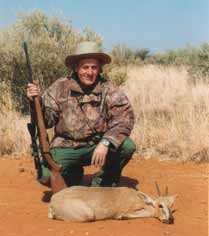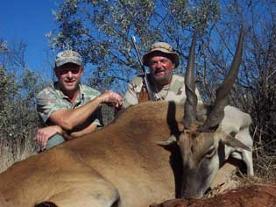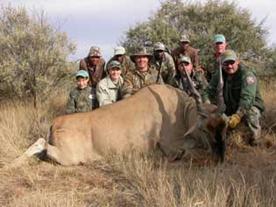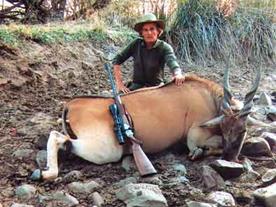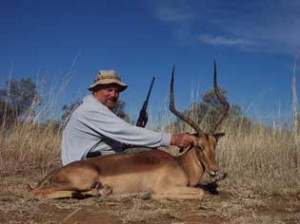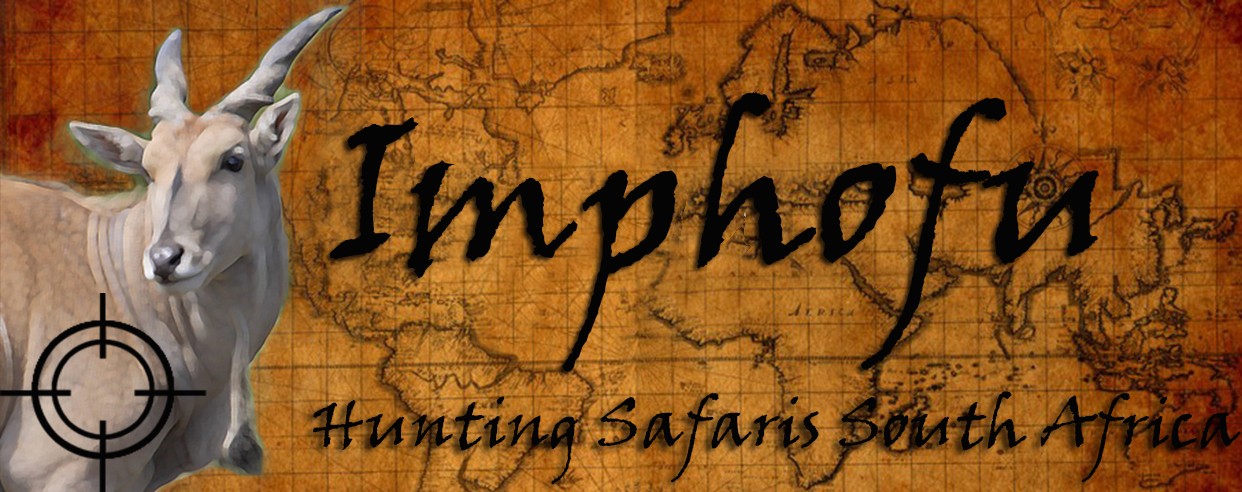
Blesbuck trophy Tom Ayer
| Blesbuck – (Damaliscus albifrons) |
| Both sexes are horned. The horns are brown in colour with strongly marked, pale-coloured rings.The meaning of “blesbuck” is “blazed buck,” referring to the white blaze on its face. A second white mark between the horns gives its scientific name, “albifrons.”In life the colour of the antelope is very remarkable: a deep purplish-brown with a beautiful purple sheen over the hair. The shining quality is largely lost in dead specimens. The chest is rufous, with the belly and inner parts of the legs white. The tail is long of mixed brown and white hairs. |
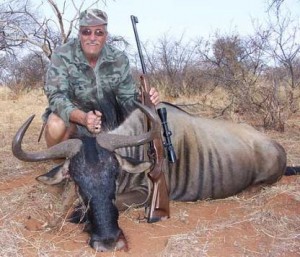
Blue Wildebeest trophy.
| Bluewildebeest (Gorgon taurinus) |
| The blue wildebeest is slate blue in colour with faint transverse bands of darker colour on the neck and forequarters. The body is slender, with light hindquarters and a disproportionately heavy head. The neck carries a rough horse-like mane and also a heavy fringe of hair along the dewlap. The shoulders are distinctly humped, with a height of about four feet (+-120 cm).Both male and female carry horns, somewhat resembling those of the buffalo but much smaller and lighter.In spite of its rather clumsy appearance it is one of the fastest veld animals when in flight, with great endurance and tenacity of life. |
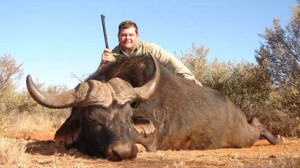
Pieter Smit from South Africa with his buffalo trophy.
| Buffalo (Syncerus caffer) |
| The buffalo’s height is almost five feet. There is little hair on the skin (almost none in older animals) except as a fringe on the ears and tail. Horns grow on both sexes, very heavy and massive in the male. The bases of the horns may expand to meet in the middle of the head, and form a solid shield impenetrable to bullets. The width of the horns may be up to three and a half feet across the bends. A charging buffalo points its head straight forward, with the horns thrown back, lowering its head sideways just as it strikes.Wounded buffalo are savage and vindictive animals, however, with considerable cunning in catching their enemy of guard |
| Duiker (Sylvicapra grimmi) |
| The duiker’s colour varies from red-brown to plain grey, but yellow-brown is most usual. The abdomen is white, and there is usually a streak of darker colour down the front of the nose. Both male and female have a tuft of up-standing reddish hair on the forehead.The male carries a pair of short straight horns, but it is rare for the females to have horns. The tale is relatively long, black above and white below.The duiker is solitary in habit, though at times found in pairs. It is not much seen during the middle of the day unless flushed from its comfortable and well-concealed “form” among herbage, but feeds in early morning or evening.When disturbed the duiker dashes away without pause, leaping high above the grass at intervals and diving down again in the way that gave it its name (duiker= diver). |
| A fully grown eland bull could be six feet high (+- 1.80m) at the shoulder and may weigh up to 1500 pounds (+-680 kg). In spite of its bulk it can clear a six foot fence comfortably.Its flesh is comparable to beef and it accumulates considerable fat — a rare feature in game animals. Being able to go extended periods without water, and feeding on both grass and bush-browse, the eland can put on condition where other animals fail altogether.The normal colour is plain dun, with light stripes down the sides. There is a dark line along the full length of the back, and a heavy dewlap on the throat in the male, which in the cow is replaced by a little bunch of hair.The eland is an easy natured and peaceful animal and is in fact very tameable. Many have been domesticated, and the eland is considered to be the most fit of all veld animals for fuller domestic breeding |
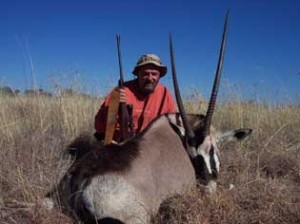
Tony Brown from the U.S.A with a Gemsbuck with tall slender horns.
| The horns of a gemsbuck are long and slender and straight, ringed at the base and smooth at the tip. Even lions fall victim at the sharp lance-like weapons at times, while lesser enemies are dealt with very severely. A wounded or weary gemsbuck fights in a lying position, the sweep of its horns long enough to cover even a flank attack.It is often suggested that the gemsbuck, with its general pony-like build and straight horns, is the original of the fabled unicorn. Seen in profile, it could easily seem to have only a single horn.They are rather less than four feet high at the shoulder, pale grey in general colour, with a dark line between the grey flanks and white belly. The face and legs are strongly marked in black and white, and there is a narrow black triangle running from the root of the tail and ending in a point on the withers. The tail is long, black and bushy-tipped, hanging almost to the ground. The whole appearance harmonises closely with the ordinary dull tints of their surroundings, and is a good protection when coupled with the gemsbuck’s keen eyesight. |
| Impala (Aepyceros melampus) |
| This, more than any other, is the buck of thick bush and mopani forest country. In undisturbed areas it assembles in herds of hundred or more, but in other places small troops of a dozen or so are more usual.The impala is about three feet high at the shoulder and of slender build, with a graceful upward sweep of the neck. The doe is hornless, but the buck has delicate horns, long for the size of the animal, ranging backwards, outwards and upwards in a lyre-shaped curve, with transverse ridges for most of the length.The skin colour is chestnut-red, lighter on the flanks, with a well-marked line between this and the pure white under parts. There is a black vertical stripe on each buttock and a black stripe on the back which is carried down onto the tail. |
| Mountain Reedbuck (Redunca arundinum) |
| By day the reedbuck lie in shelter, making a comfortable lair in deep grass. In rolling country they often move onto the ridges for the day’s sleep, bedding down in the cover of thin scrub with a wide view around.When startled or uncertain, the reedbuck stands and signals its disquiet by a loud whistle which can be heard for a considerable distance, and passes the alarm to every animal in the neighbourhood.When sheltered in thick cover, this buck generally lies tight until the hunter is within a few paces and then burst out in full gallop. When thus in flight it has a rolling, rocking-horse gait, with the rump rising high at each stride and the white underside of the bushy tail upturned like a flag |
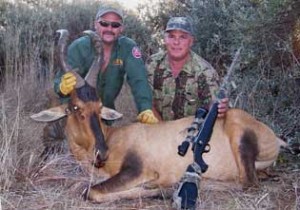
Rocky le Roux from South Africa with a Redhartebeest with a thin pointed face.
| Redhartebeest (Bubalis caama) |
| There are two species of this name within the Southern African region: the Cape- or Redhartebeest (Bubalis caama) and Lichtenstein’s Hartebeest (Bubalis lichtensteini). At Imphofu Safaris you will hunt the Redhartebeest. This species is among the swiftest of antelopes and is able to go for long periods without water. Its habit of stopping to look back at any intruder when not chased, make it an easy prey to the rifle.The Redhartebeest stand about four feet (+-120cm) tall and weighs around 300 pounds (+-136kg). It has a smooth coat of tawny rufous colour lightening to yellow on the rump, belly and inside thighs. The tail, knees and front of each leg are black. The tail being of moderate length, thinly fringed with hair towards the end.Both sexes are horned, the horns being curiously twisted. They first extend horizontally sideways, then curve up and in towards the centre-line and finally the tips, which are parallel to each other, turn again at right angles backwards. The lower portion is strongly ringed. |
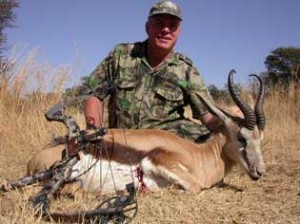
Springbuck hunted with rifles and bow.
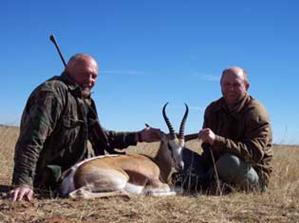
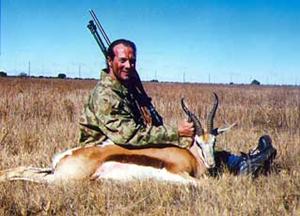
| Springbuck (Antidorcas marsupialis) |
| In former centuries great numbers of this pretty antelope ranged the high, open plains of the Karoo, where it occupied a place only comparable to that of the buffalo herds in the earliest days of North American History. Springbuck are normally gregarious, keeping together in troops of several hundred.Like other buck of the desert and semi-desert areas, springbuck rarely need to drink, though they visit water where it is available. In their natural state they dig out bulbs and succulent roots with their hoofs, and browse on the scanty herbage.A good buck stands about 33 inches (+-83 cm) high at the shoulder and weighs 70-80 pounds (30-36 kg).Both male and female carry horns, the female’s being shorter and straighter than the male’s.The general colouring is most attractive: pale reddish-brown above and white below, these areas being divided by a broad chestnut line along either flank. The face is white with a chestnut line down the cheeks. Both rump and short tale are white. |
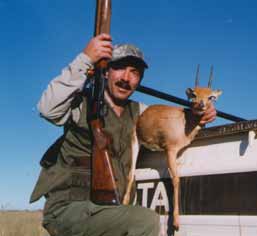
An excellent Steenbuck specimen.
| Steenbuck (Raphiceros campestris) |
| Its colour is tawny with a white belly, a close match to the tawny colour of the dry veld. The tail is the same colour. When standing in full view with its head turned towards one the most vivid impression is of slenderness in the body and big ears and big, dark eyes under white eyebrows. Its height at the shoulder is about 20 inches (+-50cm). The male carries a pair of short horns, curved slightly forward. The female has none. Single animals or pairs are the rule |
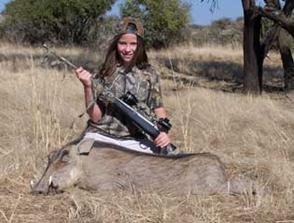
Young Tracey Ayer boasts with her warthog.
| Warthog (Phacochaerus Aethiopicus) |
| Male and female are alike, grey in colour. Heavy headed, its face deformed by large fleshy lumps (“warts”), with great curved tusks, a coarse bristly mane, thin legs, and an absurdly thin, brush-tipped tail.It is pig-like in habit, snuffling about on its knees after bulbs, roots, young shoots and grass. It is fond of wallowing in a good mud bath.Though not aggressive, it will fight savagely when cornered, and do great damage with its tusks.The warthog takes little notice of other creatures of the veld. It is the least nervous of our animals. A party approaches a waterhole at full gallop without hesitation. When disturbed, they go off at a trot again, with heads lifted and tails standing stiffly erect over their backs. |

A Waterbuck trophy.
| Waterbuck (Cobus ellipsipymnus) |
| The Waterbuck is a shaggy, coarse-haired animal about four feet (+- 120cm) high at the shoulder and varying in colour from reddish to grey. It is unfailingly identified by the oval white ring on the buttocks, a mark not carried by any other antelope. The male carries good horns, rising well up from the head and curving gently forward towards the tip. The female is hornless.Waterbuck are grass feeders. They are good swimmers too and if hunted by a lion or leopard or wild dogs, they will make for the nearest water. A solitary animal separated from the herd often takes to the river pools as final refuge. |
